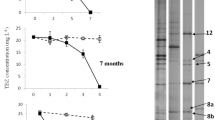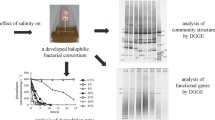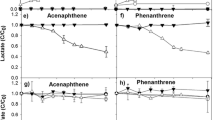Abstract
High-molecular-weight (HMW) polycyclic aromatic hydrocarbons (PAHs) are pollutants that persist in the environment due to their low solubility in water and their sequestration by soil and sediments. Although several PAH-degrading bacterial species have been isolated, it is not expected that a single isolate would exhibit the ability to degrade completely all PAHs. A consortium composed of different microorganisms can better achieve this. Two-liquid phase (TLP) culture systems have been developed to increase the bioavailability of poorly soluble substrates for uptake and biodegradation by microorganisms. By combining a silicone oil–water TLP system with a microbial consortium capable of degrading HMW PAHs, we previously developed a highly efficient PAH-degrading system. In this report, we characterized the bacterial diversity of the consortium with a combination of culture-dependent and culture-independent methods. Polymerase chain reaction (PCR) of part of the 16S ribosomal RNA gene (rDNA) sequences combined with denaturing gradient gel electrophoresis was used to monitor the bacterial population changes during PAH degradation of the consortium when pyrene, chrysene, and benzo[a]pyrene were provided together or separately in the TLP cultures. No substantial changes in bacterial profiles occurred during biodegradation of pyrene and chrysene in these cultures. However, the addition of the low-molecular-weight PAHs phenanthrene or naphthalene in the system favored one bacterial species related to Sphingobium yanoikuyae. Eleven bacterial strains were isolated from the consortium but, interestingly, only one—IAFILS9 affiliated to Novosphingobium pentaromativorans—was capable of growing on pyrene and chrysene as sole source of carbon. A 16S rDNA library was derived from the consortium to identify noncultured bacteria. Among 86 clones screened, 20 were affiliated to different bacterial species–genera. Only three strains were represented in the screened clones. Eighty-five percent of clones and strains were affiliated to Alphaproteobacteria and Betaproteobacteria; among them, several were affiliated to bacterial species known for their PAH degradation activities such as those belonging to the Sphingomonadaceae. Finally, three genes involved in the degradation of aromatic molecules were detected in the consortium and two in IAFILS9. This study provides information on the bacterial composition of a HWM PAH-degrading consortium and its dynamics in a TLP biosystem during PAH degradation.








Similar content being viewed by others
References
APHA, AWWA, WPCF (1998) Standard methods for the examination of water and wastewater. American Public Health Association, Washington, DC
Baek SH, Kim KH, Yin CR, Jeon CO, Im WT, Kim KK, Lee ST (2003) Isolation and characterization of bacteria capable of degrading phenol and reducing nitrate under low-oxygen conditions. Curr Microbiol 47:462–466
Baird WM, Hooven LA, Mahadevan B (2005) Carcinogenic polycyclic aromatic hydrocarbon-DNA adducts and mechanism of action. Environ Mol Mutagen 45:106–114
Bamforth SM, Singleton I (2005) Bioremediation of polycyclic aromatic hydrocarbons: current knowledge and future directions. J Chem Technol Biotechnol 80:723–736
Bicho PA, Martin V, Saddler JN (1995) Growth, induction, and substrate specificity of dehydroabietic acid-degrading bacteria isolated from a kraft mill effluent enrichment. Appl Environ Microbiol 61:3245–3250
Blümel S, Mark B, Busse HJ, Kämpfer P, Stolz A (2001) Pigmentiphaga kullae gen. nov., sp. nov., a novel member of the family Alcaligenaceae with the ability to decolorize azo dyes aerobically. Int J Syst Evol Microbiol 51:1867–1871
Bodour AA, Wang JM, Brusseau ML, Maier RM (2003) Temporal change in culturable phenanthrene degraders in response to long-term exposure to phenanthrene in a soil column system. Environ Microbiol 5:888–895
Bouchez M, Blanchet D, Vandecasteele JP (1995) Degradation of polycyclic aromatic hydrocarbons by pure strains and by defined strain associations: inhibition phenomena and cometabolism. Appl Microbiol Biotechnol 43:156–164
Bouchez M, Blanchet D, Bardin V, Haeseler F, Vandecasteele JP (1999) Efficiency of defined strains and of soil consortia in the biodegradation of polycyclic aromatic hydrocarbon (PAH) mixtures. Biodegradation 10:429–435
Brezna B, Khan AA, Cerniglia CE (2003) Molecular characterization of dioxygenases from polycyclic aromatic hydrocarbon-degrading Mycobacterium spp. FEMS Microbiol Lett 223:177–183
Cerniglia CE (1992) Biodegradation of polycyclic aromatic hydrocarbons. Biodegradation 3:351–368
Dagher F, Deziel E, Lirette P, Paquette G, Bisaillon JG, Villemur R (1997) Comparative study of five polycyclic aromatic hydrocarbon degrading bacterial strains isolated from contaminated soils. Can J Microbiol 43:368–377
Demanèche S, Meyer C, Micoud J, Louwagie M, Willison JC, Jouanneau Y (2004) Identification and functional analysis of two aromatic-ring-hydroxylating dioxygenases from a Sphingomonas strain that degrades various polycyclic aromatic hydrocarbons. Appl Environ Microbiol 70:6714–6725
Déziel E, Comeau Y, Villemur R (1999) Two-liquid-phase bioreactors for enhanced degradation of hydrophobic/toxic compounds. Biodegradation 10:219–233
Dohse DM, Lion LW (1994) Effect of microbial polymers on the sorption and transport of phenanthrene in a low-carbon sand. Environ Sci Technol 28:541–548
Ensley BD, Ratzkin BJ, Osslund TD, Simon MJ, Wackett LP, Gibson DT (1983) Expression of naphthalene oxidation genes in Escherichia coli results in the biosynthesis of indigo. Science 222:167–169
Gauthier E, Déziel E, Villemur R, Juteau P, Lépine F, Beaudet R (2003) Initial characterization of new bacteria degrading high-molecular weight polycyclic aromatic hydrocarbons isolated from a 2-year enrichment in a two-liquid-phase culture system. J Appl Microbiol 94:301–311
Guieysse B, Viklund G (2005) Sequential UV-biological degradation of polycyclic aromatic hydrocarbons in two-phases partitioning bioreactors. Chemosphere 59:369–376
Guieysse B, Cirne MD, Mattiasson B (2001) Microbial degradation of phenanthrene and pyrene in a two-liquid phase-partitioning bioreactor. Appl Microbiol Biotechnol 56:796–802
Guieysse B, Viklund G, Toes AC, Mattiasson B (2004) Combined UV-biological degradation of PAHs. Chemosphere 55:1493–1499
Gunam IB, Yaku Y, Hirano M, Yamamura K, Tomita F, Sone T, Asano K (2006) Biodesulfurization of alkylated forms of dibenzothiophene and benzothiophene by Sphingomonas subarctica T7b. J Biosci Bioeng 101:322–327
Habe H, Omori T (2003) Genetics of polycyclic aromatic hydrocarbon metabolism in diverse aerobic bacteria. Biosci Biotechnol Biochem 67:225–243
Huber T, Faulkner G, Hugenholtz P (2004) Bellerophon: a program to detect chimeric sequences in multiple sequence alignments. Bioinformatics 20:2317–2319
Janecka J, Jenkins MB, Brackett NS, Lion LW, Ghiorse WC (2002) Characterization of a Sinorhizobium isolate and its extracellular polymer implicated in pollutant transport in soil. Appl Environ Microbiol 68:423–426
Juhasz AL, Naidu R (2000) Bioremediation of high molecular weight polycyclic aromatic hydrocarbons: a review of the microbial degradation of benzo[a]pyrene. Int Biodeterio biodegrad 45:57–88
Kanaly RA, Harayama S (2000) Biodegradation of high-molecular-weight polycyclic aromatic hydrocarbons by bacteria. J Bacteriol 182:2059–2067
Kanaly RA, Bartha R, Watanabe K, Harayama S (2000) Rapid mineralization of benzo[a]pyrene by a microbial consortium growing on diesel fuel. Appl Environ Microbiol 66:4205–4211
Kim SJ, Kweon O, Freeman JP, Jones RC, Adjei MD, Jhoo JW, Edmondson RD, Cerniglia CE (2006) Molecular cloning and expression of genes encoding a novel dioxygenase involved in low- and high-molecular-weight polycyclic aromatic hydrocarbon degradation in Mycobacterium vanbaalenii PYR-1. Appl Environ Microbiol 72:1045–1054
Ludwig W, Strunk O, Westram R, Richter L, Meier H, Yadhukumar A, Buchner A, Lai T et al (2004) ARB: a software environment for sequence data. Nucleic Acids Res 32:1363–1371
Macedo AJ, Kuhlicke U, Neu TR, Timmis KN, Abraham WR (2005) Three stages of a biofilm community developing at the liquid-liquid interface between polychlorinated biphenyls and water. Appl Environ Microbiol 71:7301–7309
MacLeod CT, Daugulis AJ (2005) Interfacial effects in a two-phase partitioning bioreactor: degradation of polycyclic aromatic hydrocarbon (PAHs) by a hydrophobic Mycobacterium. Process Biochemistry 40:1799–1805
Mahanty B, Pakshirajan K, Venkata Dasu V (2008) Biodegradation of pyrene by Mycobacterium frederiksbergense in a two-phase partitioning bioreactor system. Bioresour Technol 99:2694–2698
Marcoux J, Déziel E, Villemur R, Lépine F, Bisaillon JG, Beaudet R (2000) Optimization of high-molecular-weight polycyclic aromatic hydrocarbons’ degradation in a two-liquid-phase bioreactor. J Appl Microbiol 88:655–662
Miller CD, Hall K, Liang YN, Nieman K, Sorensen D, Issa B, Anderson AJ, Sims RC (2004) Isolation and characterization of polycyclic aromatic hydrocarbon-degrading Mycobacterium isolates from soil. Microb Ecol 48:230–238
Mueller JG, Chapman PJ, Pritchard PH (1989) Action of a fluoranthene-utilizing bacterial community on polycyclic aromatic hydrocarbon components of creosote. Appl Environ Microbiol 55:3085–3090
Muyzer G, de Waal EC, Uitterlinden AG (1993) Profiling of complex microbial populations by denaturing gradient gel electrophoresis analysis of polymerase chain reaction-amplified genes coding for 16S rRNA. Appl Environ Microbiol 59:695–700
Nalin R, Simonet P, Vogel TM, Normand P (1999) Rhodanobacter lindaniclasticus gen. nov., sp. nov., a lindane-degrading bacterium. Int J Syst Bacteriol 49:19–23
Pinyakong O, Habe H, Omori T (2003) The unique aromatic catabolic genes in sphingomonads degrading polycyclic aromatic hydrocarbons (PAHs). J Gen Appl Microbiol 49:1–19
Puhakka JA, Herwig RP, Koro PM, Wolfe GV, Ferguson JF (1995) Biodegradation of chlorophenols by mixed and pure cultures from a fluidized-bed reactor. Appl Microbiol Biotechnol 42:951–957
Romine MF, Stillwell LC, Wong KK, Thurston SJ, Sisk EC, Sensen C, Gaasterland T, Fredrickson JK, Saffer JD (1999) Complete sequence of a 184-kilobase catabolic plasmid from Sphingomonas aromaticivorans F199. J Bacteriol 181:1585–1602
Sambrook J, Russell DW (2001) Molecular cloning, a laboratory manual, 3rd edn. Cold Spring Harbor Laboratory Press, Cold Spring Harbor
Serghini MA, Ritzenthaler C, Pinck L (1989) A rapid and efficient ‘miniprep’ for isolation of plasmid DNA. Nucleic Acids Res 17:3604
Sohn JH, Kwon KK, Kang JH, Jung HB, Kim SJ (2004) Novosphingobium pentaromativorans sp. nov., a high-molecular-mass polycyclic aromatic hydrocarbon-degrading bacterium isolated from estuarine sediment. Int J Syst Evol Microbiol 54:1483–1487
Sylvestre M (1980) Isolation method for bacterial isolates capable of growth on p-chlorobiphenyl. Appl Environ Microbiol 39:1223–1224
Toledo FL, Calvo C, Rodelas B, Gonzalez-Lopez J (2006) Selection and identification of bacteria isolated from waste crude oil with polycyclic aromatic hydrocarbons removal capacities. Syst Appl Microbiol 29:244–252
Vandermeer KD, Daugulis AJ (2007) Enhanced degradation of a mixture of polycyclic aromatic hydrocarbons by a defined microbial consortium in a two-phase partitioning bioreactor. Biodegradation 18:211–221
Villemur R, Déziel E, Benachenhou A, Marcoux J, Gauthier E, Lépine F, Beaudet R, Comeau Y (2000) Two-liquid-phase slurry bioreactors to enhance the degradation of high-molecular-weight polycyclic aromatic hydrocarbons in soil. Biotechnol Prog 16:966–972
Vinas M, Sabate J, Espuny MJ, Solanas AM (2005) Bacterial community dynamics and polycyclic aromatic hydrocarbon degradation during bioremediation of heavily creosote-contaminated soil. Appl Environ Microbiol 71:7008–7018
Vinas M, Sabate J, Guasp C, Lalucat J, Solanas AM (2005) Culture-dependent and -independent approaches establish the complexity of a PAH-degrading microbial consortium. Can J Microbiol 51:897–909
Xue W, Warshawsky D (2005) Metabolic activation of polycyclic and heterocyclic aromatic hydrocarbons and DNA damage: a review. Toxicol Appl Pharmacol 206:73–93
Yeom SH, Daugulis AJ (2001) Development of a novel bioreactor system for treatment of gaseous benzene. Biotechnol Bioeng 72:156–165
Yuan SY, Wei SH, Chang BV (2000) Biodegradation of polycyclic aromatic hydrocarbons by a mixed culture. Chemosphere 41:1463–1468
Acknowledgments
This research was supported by two grants to R. Villemur from the Natural Sciences and Engineering Research Council of Canada and the Fonds Québécois de la Recherche sur la Nature et les Technologies.
Author information
Authors and Affiliations
Corresponding author
Rights and permissions
About this article
Cite this article
Lafortune, I., Juteau, P., Déziel, E. et al. Bacterial Diversity of a Consortium Degrading High-Molecular-Weight Polycyclic Aromatic Hydrocarbons in a Two-Liquid Phase Biosystem. Microb Ecol 57, 455–468 (2009). https://doi.org/10.1007/s00248-008-9417-4
Received:
Accepted:
Published:
Issue Date:
DOI: https://doi.org/10.1007/s00248-008-9417-4




